Yamaha SRT-1000 Review
Yamaha SRT-1000
Get true surround sound from Yamaha’s debut soundbase
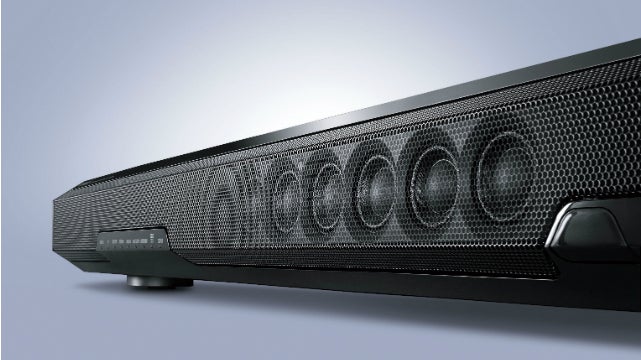
Verdict
Pros
- Sleek design and solid build
- Convincing surround sound
- Muscular, well integrated bass and crisp detail
- Excellent control app
Cons
- Surround performance dependent on room
- No HDMI inputs or front panel readout
- Not as refined as some rivals
- Expensive
Key Specifications
- Review Price: £499.00
- 5.1 surround sound from beam drivers
- Bluetooth with apt-X
- Dolby and DTS decoding
- Five Cinema DSP modes
What is the Yamaha SRT-1000?
Yamaha has long been at the forefront of soundbar technology with its series of impressive ‘digital sound projectors’, but the SRT-1000 marks its debut in the soundbase market. It’s designed to sit conveniently under your TV and produce the sort of powerful sound that your TV speakers can only dream of.
But unlike most other soundbases that only play movies and TV shows in stereo, Yamaha’s effort is gunning for ‘true’ surround sound using the same sound beam technology as its high-end soundbars. Its carefully arranged drivers ‘bounce’ these beams off the walls, theoretically resulting in a realistic 5.1 experience.
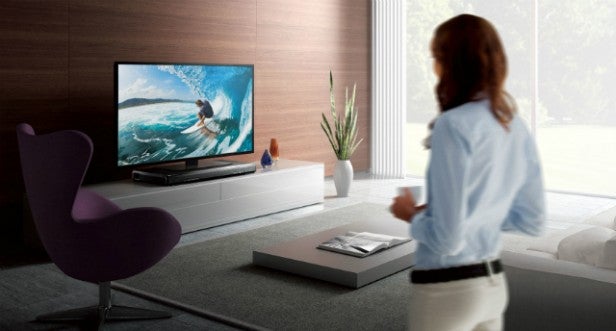
SEE ALSO: Best Soundbars Round-up
Yamaha SRT-1000 – Design and Connections
The SRT-1000 is a beautifully crafted and handsomely styled soundbase. The large cabinet is built from MDF as opposed to plastic, which makes it reassuringly rigid and robust. Give it a tap on top and there’s a solid thud, not a hollow boom.
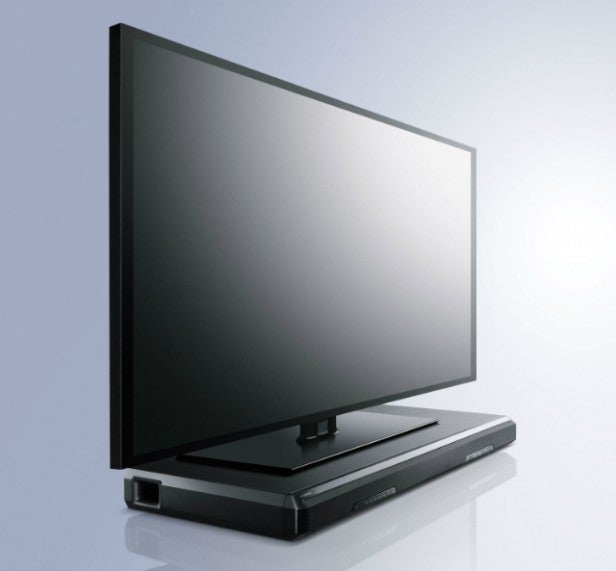
This solid construction will comfortably support TVs up to 55 inches in size, weighing no more than 40kg. The top surface measures 780mm x 370mm, so as long as your TV’s stand measures no more than 750mm by 350mm it’ll be fine. At 77mm high, the unit keeps a nice low profile under your TV.
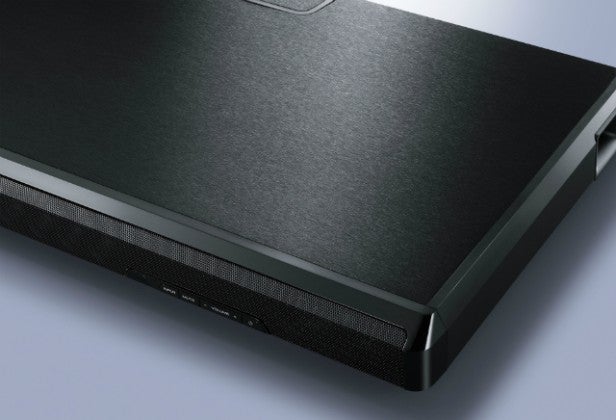
The top surface sports a fetching hairline finish, while the snazzy gloss-black trim and black metal mesh on the front are classic Yamaha. Sadly there’s no alphanumeric display on the front, just a row of lights that indicates the selected input and audio format – this is a little cryptic at first, but you’ll get used to it. On the right is a panel of buttons, including input, volume, mute and standby.
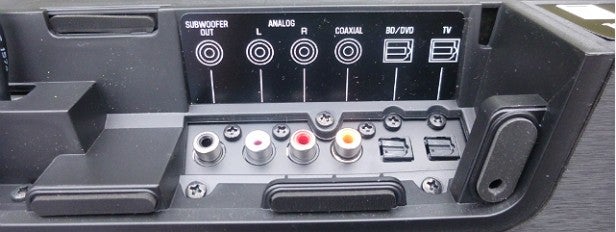
All the connections are huddled under a removable cover on the back, which hides them away and keeps the cables nice and tidy. The line-up of one coaxial and two optical digital inputs, analogue input and a subwoofer output is useful enough, but the lack of HDMI sockets is surprising.
They’re not essential, but those hoping to use the Yamaha as an HDMI switcher for Blu-ray decks and other HD sources will need to look elsewhere – Sony’s HT-XT1 and Roth’s Neo 6.2 SoundCore spring to mind, which offer three and four inputs respectively.
SEE ALSO: Best TVs Round-up
Yamaha SRT-1000 – Features
The SRT-1000 is teeming with features, chief among which is its surround sound technology. Yamaha is keen to point out that this is real 5.1-channel surround sound, not virtual. The eight 2.8cm drivers located at the front of the unit produce beams of sound that reflect off walls towards the listening position and recreate a multichannel soundstage.
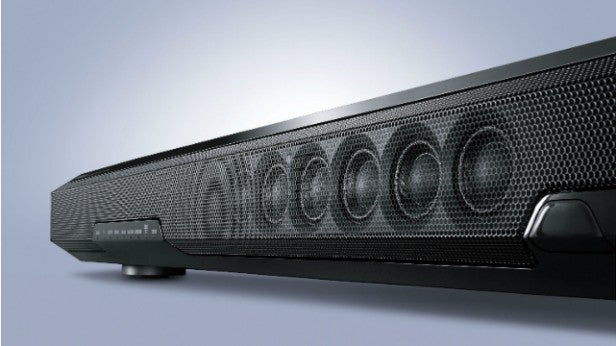
You can control how the beams behave in line with your room layout using three presets on the remote, or tweak the performance more accurately using Yamaha’s HT Controller app (more on that later).
The beam drivers are joined by two 4cm x 10cm oval woofers on the front and two 8.5cm subwoofers on the bottom. Independent bass reflex ports for each sub reduce unwanted resonance by ensuring a smooth flow of air.
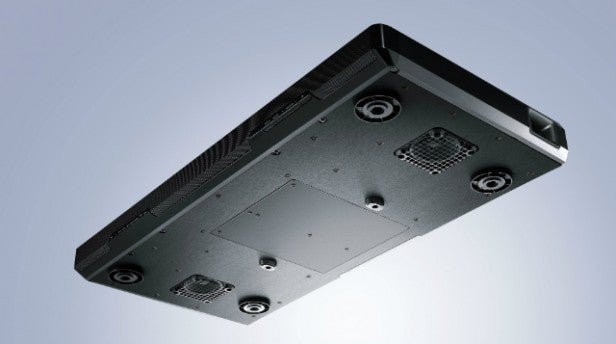
Each beam driver outputs 2W, while the front and bottom woofers output 30W each, making a total quoted power output of 136W.
There are five Cinema DSP surround modes – Movie, Music, Sports, Game and TV Program – while the Clear Voice mode is designed to give dialogue a boost. The SRT-1000 also decodes Dolby Digital and DTS, which gives you the full 5.1 experience if you hook up a Blu-ray or DVD player to the optical input (TVs typically only output stereo PCM).
Other features include Bluetooth with support for apt-X audio coding and UniVolume, which keeps the volume consistent when that SafeStyle UK bloke starts shouting at you during the adverts.
Yamaha SRT-1000 – Setup and Operation
Physical installation simply involves placing the SRT-1000 under your TV and plugging in the cables, but audio configuration takes a bit longer.
Firstly you have to tell the SRT-1000 whereabouts in the room it’s placed by holding down one of the three dedicated keys on the remote for three seconds – nearer the left wall, in the middle or nearer the right wall. Alternatively you can set your room size in the control app by dragging the walls around onscreen, or move the little man in the middle to the correct spot. It’s a lot of fun.
Next you can adjust the individual channel levels using a series of test tones, and tweak the subwoofer volume using the dedicated keys on the remote. This level of control is commendable.
However, the row of lights on the front isn’t the best visual guide when tweaking. For example, when adjusting the individual channel levels, each channel is represented by a different pattern of lights, which is confusing if you don’t have the manual to hand. It’s not rocket science but we prefer the accuracy of actual numbers.
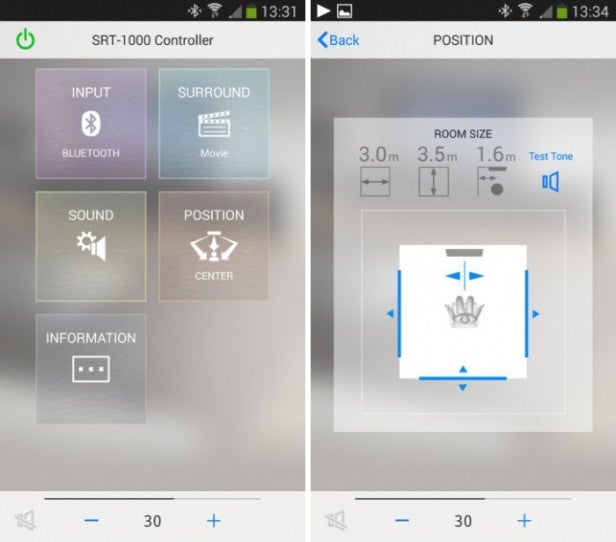
With that in mind, we highly recommend downloading the HT Controller app for Android and iOS devices, which makes operation much easier. The simple tile-based layout and classy graphics are a joy to navigate, allowing you to access every sound mode and input, as well as the afore-mentioned position settings.
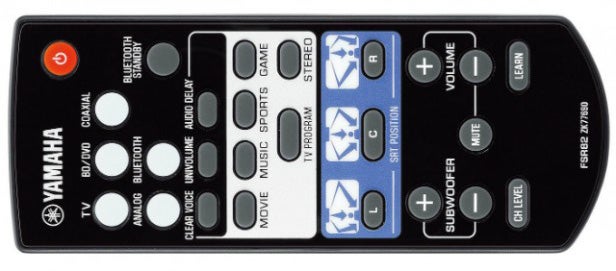
The physical remote is also impressive, boasting an ergonomic shape and a straightforward button layout. The keys are separated into helpful groups and clearly labelled. Dedicated buttons for each input and sound mode means you don’t have to toggle through them all to reach the one you want. If you don’t like it, the unit will learn the commands from your existing TV’s remote.
Yamaha SRT-1000 – Performance
The SRT-1000’s impressive performance turns a movie from something you watch into something you experience. We played superb sci-fi romp Edge of Tomorrow on Blu-ray – taking advantage of the built-in DTS decoding by hooking up our player directly to the optical input – and the Yamaha delivers the action with aplomb.
Crucially it offers a massive step up in depth and power from flatscreen TV speakers. Through our weedy LED set, the movie’s explosions and gunshots sound thin and brittle with practically no bass depth at all.
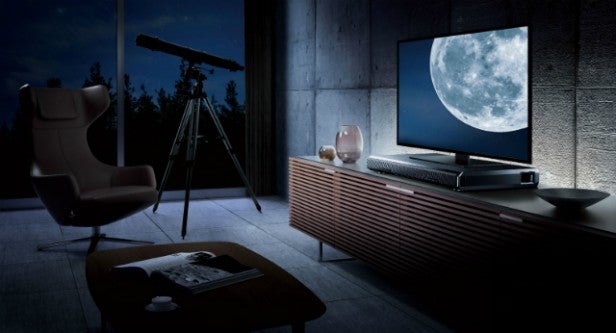
But through the Yamaha they become richer and punchier, thudding through your chest and filling the room – no mean feat for a box barely taller than a Blu-ray player.
So when Cage and his squad are dropped onto the beach, the constant chug of machine gun fire is underpinned by a solid rumble and Quadcopters slam into the ground with a tight, muscular thump.
This bass output is cohesive and well controlled, testament to the effectiveness of the reflex ports. Sure, it booms a bit if you get trigger happy with the subwoofer volume controls, but keep it just below the half way mark and it integrates beautifully.
Tonally there’s plenty of bite in the highs but not so much that it sounds bright or brash – Yamaha has struck a lovely balance here. It results in a detailed, attacking sound that keeps excitement high, crucial for conveying the energy of the movie’s battle scenes, plus it remains easy and enjoyable with the volume up loud. Fizzing sand and swishing missiles are crisp and airy.
Dialogue reproduction is first class too – Sgt Farell’s barked orders stand out above the hubbub of the quadcopter as the soldiers are about to drop.
As for the SRT-1000’s surround sound, it’s the best we’ve heard from a soundbase. It conjures up a wide and spacious soundstage and pings those missiles and gunshots out towards the listening position. Inevitably it’s not as well defined as a real 5.1 system but there’s definite surround presence – this is as close as you’re likely to get from an under-TV speaker.
However, we should point out that it’s hugely dependent on your room layout. There’s a long list of reasons in the manual why it might not work, including proximity to the wall, obstacles, corner placement and room size, and in practice it was hit and miss – our test room was far too wide and it didn’t work at all, but we had more success in a smaller room with closer walls.
It’s not the end of the world if your room’s not suitable though – the Yamaha’s naturally spacious, room-filling sound still makes you feel enveloped.
Music sounds terrific in stereo mode but don’t be tempted to use the awful ‘Music’ preset, which adds an echo and overemphasises the mids, making everything sound unnatural.

Should I buy the Yamaha SRT-1000?
If you want a soundbase but don’t want to miss out on surround sound, then the SRT-1000 is the one for you. It’s the only model we’ve heard that delivers ‘real’ surround effects, bouncing them off the walls to create a spacious, immersive soundstage. It won’t work in every room though, so make sure yours is suitable.
Elsewhere the SRT-1000 also boasts lots of cool features and a sleek design, while its dynamic, weighty sound is a treat. That said, price is an issue – at close to £500 it’s one of the most expensive soundbases on the market, which makes the lack of HDMI inputs a little disappointing. And although its performance is impressive, we still prefer the more refined and authoritative sound of the cheaper Canton DM75.
Verdict
Yamaha’s debut soundbase is the first to deliver convincing surround sound, backed up by attractive features and a stylish design – although the cheaper Canton offers a more assured performance.
Next, read more Surround Sound System Reviews
Trusted Score
Score in detail
-
Performance 8
-
Features 8
-
Value 8
-
Sound Quality 9
-
Design 9
Features
| 3D Ready | No |
| Number of Speakers | 12 |
| Supported Channels | 5.1 |
| DVD Player | No |
| Blu-ray player | No |
| Audio Processing | Cinema DSP |
| Dolby Digital | Yes |
| DTS | Yes |
| Dolby Pro Logic II | Yes |
| Dolby TrueHD | No |
| DTS Master Audio HD | No |
Connectors
| S/PDIF Optical In | 2 |
| S/PDIF Coax In | 1 |
| Subwoofer Out | 1 |
| Stereo Line In | 1 |
| Power (Watt) | 136W |
Physical Specifications
| Height (Millimeter) | 77mm |
| Width (Millimeter) | 780mm |
| Depth (Millimeter) | 370mm |
| Weight (Gram) | 8.8kg |

